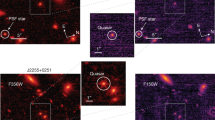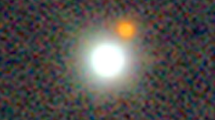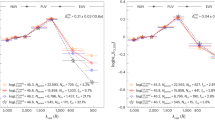Abstract
The intergalactic medium was not completely reionized until approximately a billion years after the Big Bang, as revealed1 by observations of quasars with redshifts of less than 6.5. It has been difficult to probe to higher redshifts, however, because quasars have historically been identified2,3,4 in optical surveys, which are insensitive to sources at redshifts exceeding 6.5. Here we report observations of a quasar (ULAS J112001.48+064124.3) at a redshift of 7.085, which is 0.77 billion years after the Big Bang. ULAS J1120+0641 has a luminosity of 6.3 × 1013L⊙ and hosts a black hole with a mass of 2 × 109M⊙ (where L⊙ and M⊙ are the luminosity and mass of the Sun). The measured radius of the ionized near zone around ULAS J1120+0641 is 1.9 megaparsecs, a factor of three smaller than is typical for quasars at redshifts between 6.0 and 6.4. The near-zone transmission profile is consistent with a Lyα damping wing5, suggesting that the neutral fraction of the intergalactic medium in front of ULAS J1120+0641 exceeded 0.1.
This is a preview of subscription content, access via your institution
Access options
Subscribe to this journal
Receive 51 print issues and online access
$199.00 per year
only $3.90 per issue
Buy this article
- Purchase on Springer Link
- Instant access to full article PDF
Prices may be subject to local taxes which are calculated during checkout




Similar content being viewed by others
References
Fan, X. et al. Constraining the evolution of the ionizing background and the epoch of reionization with z∼6 quasars. II. A sample of 19 quasars. Astron. J. 132, 117–136 (2006)
Fan, X. et al. A survey of z>5.8 quasars in the Sloan Digital Sky Survey. I. discovery of three new quasars and the spatial density of luminous quasars at z∼6. Astron. J. 122, 2833–2849 (2001)
Fan, X. et al. A survey of z>5.7 quasars in the Sloan Digital Sky Survey. II. Discovery of three additional quasars at z>6. Astron. J. 125, 1649–1659 (2003)
Willott, C. J. et al. The Canada-France High-z Quasar Survey: nine new quasars and the luminosity function at redshift 6. Astron. J. 139, 906–918 (2010)
Miralda-Escude, J. Reionization of the intergalactic medium and the damping wing of the Gunn-Peterson trough. Astrophys. J. 501, 15–22 (1998)
Lawrence, A. et al. The UKIRT Infrared Deep Sky Survey (UKIDSS). Mon. Not. R. Astron. Soc. 379, 1599–1617 (2007)
York, D. G. et al. The Sloan Digital Sky Survey: technical summary. Astron. J. 120, 1579–1587 (2000)
Mortlock, D. J. et al. Probabilistic photometric quasar selection. Mon. Not. R. Astron. Soc. (in the press)
Dunkley, J. et al. Five-year Wilkinson Microwave Anisotropy Probe observations: likelihoods and parameters from the WMAP data. Astrophys. J. Suppl. 180, 306–329 (2009)
Lehnert, M. D. et al. Spectroscopic confirmation of a galaxy at redshift z ≃ 8.6. Nature 467, 940–942 (2010)
Vanzella, E. et al. Spectroscopic confirmation of two Lyman break galaxies at redshift beyond 7. Astrophys. J. 730, L35–L40 (2011)
Tanvir, N. R. et al. A γ-ray burst at a redshift of z ≃ 8.2. Nature 461, 1254–1257 (2009)
Willott, C. J. et al. Eddington-limited accretion and the black hole mass function at redshift 6. Astron. J. 140, 546–560 (2010)
Willott, C. J. et al. Four quasars above redshift 6 discovered by the Canada-France High-z Quasar Survey. Astron. J. 134, 2435–2450 (2007)
Hewett, P. C. & Wild, V. Improved redshifts for SDSS quasar spectra. Mon. Not. R. Astron. Soc. 405, 2302–2316 (2010)
Richards, G. T. et al. Unification of luminous Type 1 quasars through C IV emission. Astron. J. 141, 167–182 (2011)
Becker, R. H., White, R. L. & Helfand, D. J. The FIRST survey: faint images of the radio sky at twenty centimeters. Astrophys. J. 450, 559–577 (1995)
Telfer, R. C., Zheng, W., Kriss, G. A. & Davidsen, A. F. The rest-frame extreme-ultraviolet spectral properties of quasi-stellar objects. Astrophys. J. 565, 773–785 (2002)
Vestergaard, M. & Osmer, P. S. Mass functions of the active black holes in distant quasars from the Large Bright Quasar Survey, the Bright Quasar Survey, and the color-selected sample of the SDSS fall equatorial stripe. Astrophys. J. 699, 800–816 (2009)
Volonteri, M. & Rees, M. J. Quasars at z ≃ 6: the survival of the fittest. Astrophys. J. 650, 669–678 (2006)
Willott, C. J., McLure, R. J. & Jarvis, M. J. A 3×109M ⊙ black hole in the quasar SDSS J1148+5251 at z 6.41. Astrophys. J. 587, L15–L18 (2003)
Haiman, Z. The origin and detection of high-redshift supermassive black holes. AIP Conf. Ser. (eds Whalen, D. J., Bromm, V. & Yoshida, N. ) 1294, 215–224 (American Institute of Physics, 2010)
Carilli, C. L. et al. Ionization near zones associated with quasars at z∼6. Astrophys. J. 714, 834–839 (2010)
Haiman, Z. The detectability of high-redshift Lyα emission lines prior to the reionization of the universe. Astrophys. J. 576, L1–L4 (2002)
Bolton, J. S. & Haehnelt, M. G. The nature and evolution of the highly ionized near-zones in the absorption spectra of z ≃ 6 quasars. Mon. Not. R. Astron. Soc. 374, 493–514 (2007)
Wyithe, J. S. B., Loeb, A. & Carilli, C. Improved constraints on the neutral intergalactic hydrogen surrounding quasars at redshifts z > 6. Astrophys. J. 628, 575–582 (2005)
Mesinger, A. & Haiman, Z. Evidence of a cosmological Strömgren surface and of significant neutral hydrogen surrounding the quasar SDSS J1030+0524. Astrophys. J. 611, L69–L72 (2004)
Calverley, A. P., Becker, G. D., Haehnelt, M. G. & Bolton, J. S. Measurements of the UV background at 4.6 < z < 6.4 using the quasar proximity effect. Mon. Not. R. Astron. Soc. 420, 1–10 (2010)
White, R. L., Becker, R. H., Fan, X. & Strauss, M. A. Probing the ionization state of the Universe at z>6. Astron. J. 126, 1–14 (2003)
Gunn, J. E. & Peterson, B. A. On the density of neutral hydrogen in intergalactic space. Astrophys. J. 142, 1633–1641 (1965)
Acknowledgements
M.P. acknowledges support from the University of London’s Perren Fund. P.C.H. and R.G.McM. acknowledge support from the STFC-funded Galaxy Formation and Evolution programme at the Institute of Astronomy. X. Fan and R. White supplied spectra of the SDSS quasars. M. Haehnelt provided insights into quasar near-zone physics. The staffs of the Joint Astronomy Centre, the Cambridge Astronomical Survey Unit and the Wide-Field Astronomy Unit, Edinburgh, all made vital contributions to the UKIDSS project. The support staff at the Gemini North Telescope, particularly K. Roth, provided assistance with the Gemini observations. This work is based in part on data obtained from UKIDSS, SDSS, the Liverpool Telescope, the Isaac Newton Telescope, the Gemini Observatory and the European Southern Observatory.
Author information
Authors and Affiliations
Contributions
D.J.M., S.J.W., M.P., B.P.V., P.C.H., R.G.McM. and C.S. identified ULAS J1120+0641 and obtained the follow-up observations. S.J.W., P.C.H., D.J.M., T.T., B.P.V., R.G.McM. and M.P. analysed the follow-up observations and interpreted the results. A.A., S.D., E.A.G.-S., N.C.H., P.H., M.J.I. and A.L. obtained, analysed and disseminated the UKIDSS data. E.K. and H.J.A.R. obtained the FORS2 spectrum of ULAS J1120+0641. D.J.M. and S.J.W. wrote the manuscript, into which all other authors had input.
Corresponding author
Ethics declarations
Competing interests
The authors declare no competing financial interests.
Rights and permissions
About this article
Cite this article
Mortlock, D., Warren, S., Venemans, B. et al. A luminous quasar at a redshift of z = 7.085. Nature 474, 616–619 (2011). https://doi.org/10.1038/nature10159
Received:
Accepted:
Published:
Issue Date:
DOI: https://doi.org/10.1038/nature10159
This article is cited by
-
Evidence for heavy-seed origin of early supermassive black holes from a z ≈ 10 X-ray quasar
Nature Astronomy (2023)
-
Turbulent cold flows gave birth to the first quasars
Nature (2022)
-
A dusty compact object bridging galaxies and quasars at cosmic dawn
Nature (2022)
-
Modeling cosmic reionization
Living Reviews in Computational Astrophysics (2022)
-
Quantumbit Cosmology Explains Effects of Rotation Curves of Galaxies
Foundations of Science (2022)
Comments
By submitting a comment you agree to abide by our Terms and Community Guidelines. If you find something abusive or that does not comply with our terms or guidelines please flag it as inappropriate.



